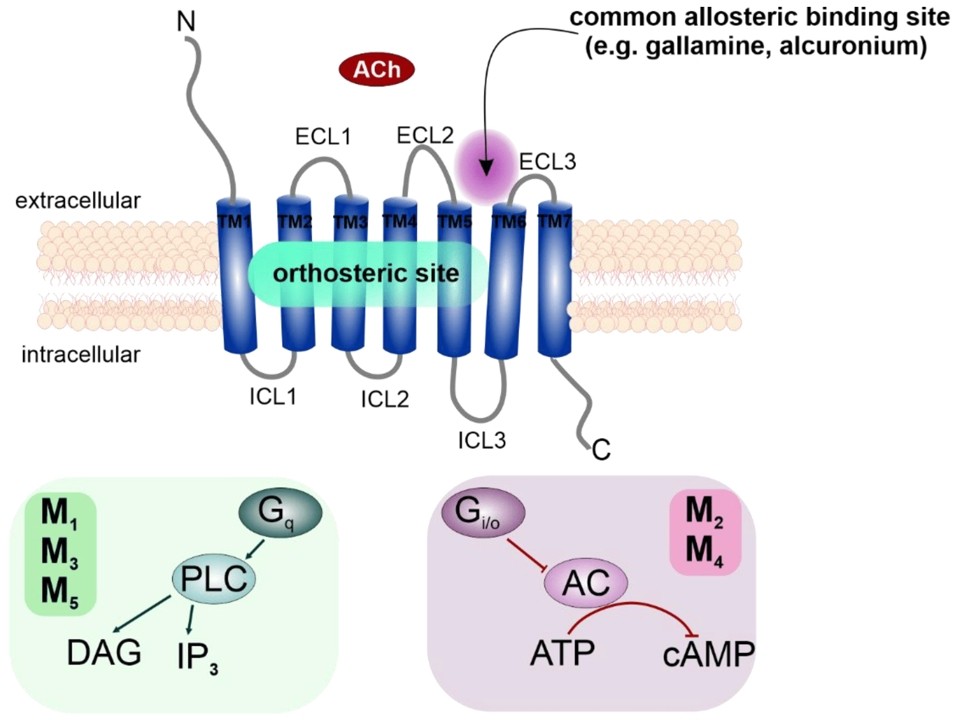Hi-Affi™ M5 Stable Cell Line
G protein-coupled receptors (GPCRs) play a crucial part in a variety of cellular physiological processes, which manifest as one popular therapeutic target for approximately 30%-40% current marketed drugs. Testing the function profiles of different compounds against GPCRs has always been a pivotal challenge in GPCR drug discovery. Aiming at addressing this particular challenge, Creative Biolabs has successfully established an innovative Hi-Affi™ stable cell platform for GPCR receptor function screening. Especially, we now provide a full range GPCR stable line engineered with calcium-activated biosensors that are capable of monitoring GPCR activities in real time. Here, our scientists are happy to introduce our Hi-Affi™ M5 stable cell line to worldwide researcher.
Introduction to M5 Receptor
The muscarinic acetylcholine receptors belong to the GPCR family that interact with G-proteins to initiate intracellular responses. It is composed of five different subtypes: M1, M2, M3, M4, and M5 receptors. After activated by an agonist, M5 will accelerate the rate of phosphatidylinositol 4,5-bisphosphate (PIP2) hydrolysis and increase the formation of inositol 1,4,5-trisphosphate (InsP3) and diacylglycerol (DAG). It has been shown that these products act as second messengers by activating protein kinase(s) C (PCK) and mobilizing Ca2+ from intracellular stores respectively.
 Fig.1 Schematic structure of mAChRs and their preferential signaling pathways.1, 2
Fig.1 Schematic structure of mAChRs and their preferential signaling pathways.1, 2
It is evidenced that M5 receptors are widely expressed in ventral tegmental and substantia nigra areas of the brain, indicating a possible role dopamine transmission. In the periphery, it is expressed at low levels in salivary gland and iris-ciliary muscle.
Hi-Affi™ M5 Stable Cell Line
By co-expressing human Muscarinic 5 receptor (M5) and a special calcium-responsive biosensor on U2OS cell membrane, Hi-Affi™ M5 stable cell line can detect GPCR activities in a highly sensitive, highly efficient way. In response to agonistic/antagonistic compound, alterations in GPCR pathways will translate into fluorescent signals via the membrane-associated biosensor (translocating from membrane into cytosolic vesicles). This assay format is very easy, quantified, straightforward, and compatible with high-throughput screening processes.
Featured Advantages of Hi-Affi™ M5 Stable Cell Lines
- Time-, cost-saving
- Simple operations, with no special requirements for reagents or equipment
- Suitable for high-throughput screening
- No modifications/labeling of target protein or relevant pathways, maximally preserving the native signaling events
Creative Biolabs has long been a multi-dimensional service and product provider always dedicated to fulfilling every custom expectations and demands. Of note, we also offer many other Hi-Affi™ engineered cell lines to assess calcium-, cAMP-, DAG-related as well as multiplex pathway events. If you cannot find your desired target in our catalog, we are always happy to construct a custom cell line for you. Please contact us for more information and a detailed quote.
References
- Szczurowska, Ewa, et al. "Allosteric modulation of muscarinic receptors by cholesterol, neurosteroids and neuroactive steroids." International Journal of Molecular Sciences 23.21 (2022): 13075.
- under Open Access License CC BY 4.0, without modification.
For Research Use Only.
